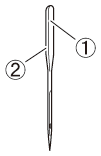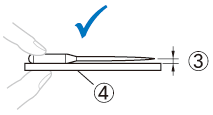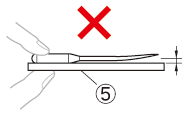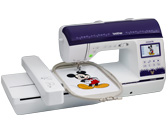Innov-is NQ3500D
FAQs & Troubleshooting |
Combination of fabric, thread and needle
 Fabric / Thread / Needle Combinations
Fabric / Thread / Needle Combinations
The sewing machine needle is probably the most important part of the sewing machine.
Choosing the proper needle for your sewing project will result in a beautiful finish and fewer problems.
Below are some things to keep in mind about needles.
-
Thread and needle number
The lower the thread number is, the heavier the thread; the higher the needle number, the larger the needle. -
Ball point needle (gold colored)
To avoid skipped stitches use ball point needles (75/11–90/14) with stretch fabrics. -
Transparent nylon thread
Use a 90/14 to 100/16 needle, regardless of the fabric or thread.
-
Embroidery needles (Embroidery only)
Use a 75/11 home machine needle. When embroidering on heavier fabrics such as denim, use a 90/14 or 100/16 home machine needle.
- Only use sewing machine needles for home use. Other needles may bend or break and cause injury.
- Never sew with a bent needle. A bent needle will easily break and cause injury.
Sewing with a bent needle is extremely dangerous since the needle may break while the machine is being operated.
Before using the needle, place the flat side of the needle on a flat surface and check that the distance between the needle and the flat surface is even.

(1) Flat side (2) Needle type marking
- Correct needle

(3) Parallel space (4) Flat surface
- Incorrect needle
If the distance between the needle and the flat surface is not even, the needle is bent.
Do not use a bent needle.

(5) Flat surface
The sewing machine needle that should be used depends on the fabric and thread thickness.
Refer to the following table when choosing the thread and needle appropriate for the fabric that you wish to sew.
| Fabric Type/Application | Thread | Size of Needle | ||
|---|---|---|---|---|
| Type | Size | |||
| Medium weight fabrics | Broadcloth | Cotton thread | 60 – 90 | 75/11 – 90/14 |
| Taffeta | Synthetic thread | |||
| Flannel, Gabardine |
Silk thread | 50 | ||
| Thin fabrics | Lawn | Cotton thread | 60 – 90 | 65/9 – 75/11 |
| Georgette | Synthetic thread | |||
| Challis, Satin |
Silk thread | 50 | ||
| Heavy fabrics | Denim | Cotton thread | 30 | 100/16 |
| 50 | 90/14 – 100/16 | |||
| Corduroy | Synthetic thread | 50 – 60 | ||
| Tweed | Silk thread | |||
| Stretch fabrics | Jersey | Thread for knits | 50 – 60 | Ball point needle 75/11 – 90/14 (gold colored) |
| Tricot | ||||
| Easily frayed fabrics | Cotton thread | 50 – 90 | 65/9 – 90/14 | |
| Synthetic thread | ||||
| Silk thread | 50 | |||
| For top-stitching | Synthetic thread | 30 | 100/16 | |
| Silk thread | 50 – 90 | 90/11 - 90/14 | ||
The appropriate fabric, thread and needle combinations are shown in the table above. If the combination of the fabric, thread and needle is not correct, particularly when sewing heavy fabrics (such as denim) with thin needles
(such as 65/9 to 75/11), the needle may bend or break. In addition, the stitching may be uneven or puckered or there may be skipped stitches.





